River Welland
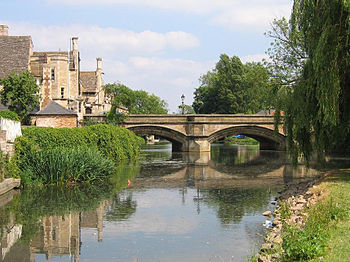
The River Welland is a river in the lowlying lands of the Midlands flowing for 65 miles through four counties; through Northamptonshire, Leicestershire, Rutland and finally Lincolnshire, where it enters the Wash. It drains a fair area of the Midlands.
The river rises in the Hothorpe Hills, at Sibbertoft in Northamptonshire, then flows generally north-east to Market Harborough, Stamford and Spalding, to reach The Wash near Fosdyke. It is a major waterway across the the Fens of Holland, and is one of the Fenland rivers which were laid out with washlands. There are two channels between widely spaced embankments with the intention that flood waters would have space in which to spread while the tide in the estuary prevented free egress. However, after the winter floods of 1947, new works such as the Coronation Channel were constructed to control flooding in Spalding and the washes are no longer used solely as pasture, but may be used for arable farming.
Geography
Drainage basin
The River Welland, with its tributaries, form a river system with a basin of 609 square miles. Within this area, 257 miles of waterway are designated as "main river", and are therefore managed for flood control by the Environment Agency under the River Welland Catchment Flood Management Plan (CFMP).[1] Of this total, the 14 miles below Spalding are tidal, and have sea walls to protect the adjacent land from flooding, while 56 miles are fresh water, but run through low-lying land, and are therefore embanked. Within the rive basin, 179 square miles are below sea level, and would be flooded without such defences.[2]
The basin runs in a broadly south-west to north-east direction, with an extension to the north around the West Glen and East Glen rivers. The underlying geology consists of Lias clays at the western end of the catchment, with Lincolnshire limestone in the centre, including the valleys of the Glen. The eastern third is mostly alluvial soils, and it is this part that relies on artificial pumping to prevent flooding. Rainfall over the area varies between 26 and 30 inches a year, which is quite light, and because the land is efficiently drained during the winter months, there are few reserves, making the area prone to drought in the summer months.[2]
Course
For much of its length the Welland forms the county border between Northamptonshire and Leicestershire or Rutland, and lower down between Lincolnshire and Northamptonshire (the Soke of Peterborough).
The Welland rises in the Hothorpe Hills, close to the 540-foot contour, near Welland Rise, Sibbertoft in Northamptonshire. Within two miles, the small stream forms the border between Northamptonshire and Leicestershire. It flows westwards, before looping round, passing through the grounds of Hothorpe Hall in Theddingworth, to flow generally eastwards through Lubenham to Market Harborough. One of the driveways to Thorpe Lubenham Hall is carried over the river by an early nineteenth century ashlar bridge which is a Grade II listed structure.[3] To the east of Lubenham, the river passes Old Lubenham Hall, part of an H-plan house built in the late sixteenth century and modified in the early eighteenth century. King Charles I is believed to have stayed there before the Battle of Naseby.[4] Three arms of a square moat surround the house, filled from the river.[5]
Market Harborough to Stamford
The river runs through the middle of Market Harborough, bringing the Leicestershire-Northamptonshire county border with it, dividing the town in twain. The River Jordan joins the Welland in the centre of Market Harborough, flowing northwards to the railway station.
Langton Brook and Stonton Brook join from the west near Welham. The county border meanders from side to side across relatively straight sections of the river, suggesting that the channel has been engineered. A three-arched bridge, built in 1881 of fine ashlar masonry, with a causeway to the south, carries the Welham to Weston by Welland road over the river,[6] while a four-arched bridge dating from the early nineteenth century carries the Ashley to Medbourne road.[7] The Macmillan Way, a long distance footpath, crosses on its way from Abbotsbury in Dorset to Boston in Lincolnshire. Medbourne Brook joins from the north, after which the river approaches a dismantled railway and is joined by the Stoke Albany Brook, approaching from the south. The river remains on the south side of the railway, while the county border follows a meandering course to the north of it, but rejoins the river near the Bringhurst to Cottingham road. The bridge over the river is plain, but to the north of it is an eighteenth-century causeway, some 110 yards long, which is made of stone and pierced by seven large arches and numerous smaller arches for drainage pipes. The causeway has two large semi-circular passing places on its western side.[8]
The Welland passes to the north of Corby near Rockingham, and then to the south of Caldecott, where it becomes the county border between Northamptonshire and Rutland, and the Eye Brook, which has been dammed to form the Eyebrook Reservoir, joins from the north. As it flows past Harringworth, the river forms two channels, with the county border following the smaller, northern channel. It is crossed by the 1,275-yard Welland Viaduct, with its 82 brick arches, which was completed in 1879,[9] and carries the Oakham to Kettering Line over the valley. Apart from viaducts carrying suburban lines into London, it is the longest railway viaduct to be built in Britain.[10]
Uppingham Brook flows eastwards from Uppingham to join on the north bank, and the Jurassic Way long distance footpath crosses the river at Turtle Bridge. This probably dates from the fourteenth century, although it was widened in 1793, and a parapet has been added subsequently.[11]
On the road from Barrowden to Wakerley, there is a mediæval bridge with five pointed arches, which was widened in the eighteenth century.[12] Gretton Brook flows from the south to join the river near Duddington, where there is a well-known mill building of earliest known date 1664.[13] A limestone ashlar bridge with four arches crosses the river, dating from the fifteenth century but widened in 1919.[14]
After the river passes under a railway bridge at Ketton, its flow is swelled by the River Chater. The county border again leaves the river to the west of Stamford while below the town the river forms the border between Lincolnshire and the Soke of Peterborough, the north-eastern part of Northamptonshire.
Stamford to Spalding
Just before Stamford, the Great North Road, now labelled the A1, crosses the river, and a pumping station on the north bank at Stamford Meadows has pumped large quantities of water to the Rutland Water reservoir since its construction in 1975.[15] Stamford was the lowest point at which the river could be forded so the Roman Ermine Street crossed the Welland there. The A16 road crosses the river by a three-arched stone bridge designed by Edward Browning in 1845.[16] Below it, Albert Bridge is made of iron with stone piers, and was erected by Stamford Town Council in July 1881, to replace an earlier bridge which was washed away in a flood.[17]
Below Stamford, the river passes the site and ruins of the Benedictine St Leonard's Priory.[18] Hudd's Mill marks the point at which the Stamford Canal left the river. The present mill building dates from 1751 and 1771.[19]
The River Gwash, which the canal crossed on the level, joins from the north, and the remains of the canal follow the river on its north bank. Below Uffington, the county border follows the old course of the river, first to the south to Tallington and then to the north, while the main course now flows along the Maxey Cut to Peakirk. The old course consists of two streams, fed by sluices from the Maxey Cut, which meander to The Deepings. The eastern stream supplied power to Lolham and Maxey mills, while the western stream did the same for Tallington Mill, which dates from around 1700,[20] West Deeping mill, and Molecey's mill, which still retains its seventeenth-century undershot waterwheel, modified in the 19th century to Poncelet's improved design, and the only surviving waterwheel of its type in Lincolnshire.[21] At the western edge of Market Deeping the two streams join, and they are also joined by the Greatford Cut, which has carried the diverted waters of the West Glen river since the early 1950s.
This section is crossed by King Street, which follows the course of a Roman road. Where it crosses the Maxey Cut, to the south of the original channels, there are a series of 14 arches which comprise Lolham Bridges. They are grouped into five structures to cross the channels in the area, and were funded by the County of Northampton in the seventeenth and eighteenth centuries. The longest span is 16 feet, and the cutwaters carry inscribed stones recording the County justices’ involvement.[22] To the north, an early nineteenth century stone rubble arched bridge carries the road over a drainage ditch near Lolham Mill,[23] while an eighteenth-century bridge, probably rebuilt in the following century, crosses the mill stream.[24] Another pair of early nineteenth century bridges, built of coursed limestone with ashlar dressings, carry the road over the northernmost channel.[25]
The bridge at Deeping Gate carries the date 1651, and is a Grade II* listed stone structure with three round arches.[26] After the remains of Deeping High lock and Deeping Low lock, there is a junction where the old course, the Maxey Cut, the South Drain and the Folly River, also a drain, meet. The river is officially navigable below this point.[27] Through Crowland and Cowbit to the edge of Spalding, the river is laid out with washlands,[28] which were historically used as pasture, because the river was allowed to flood the land when tidal levels prevented the water discharging into the sea. The river is bounded on the north and west by a bank, while the New River, a drainage channel to the south and east of it, is bounded by another bank. The land between the channels forms Crowland High Wash, Crowland Fodder Lots and Cowbit Wash. The southern bank is variously named Corporation Bank, Wash Bank and Barrier Bank. These wash lands were designed to be flooded in extremis, although the building of the Coronation flood relief channel has made this purpose obsolete.
Spalding to the Wash
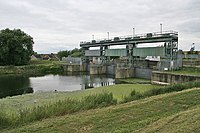
Passing through Spalding, where most of the flow is diverted through the Coronation Channel, the town is protected by Marsh Road sluice and a sea lock to the east. Below the town, it is approached by Vernatt's Drain, which runs parallel to the river carrying water pumped from Deeping Fen, and is crossed by the A16 road bridge. Nearby is Pinchbeck Marsh Pumping Station, which houses the last beam engine and scoop wheel to be used in the Fens for land drainage. It was built in 1833, and ran until 1952, when it was replaced by electric pumps. It now forms part of a museum of land drainage run by the Welland and Deepings Internal Drainage Board, in partnership with South Holland District Council.[29] Vernatt's Drain passes through a sluice to join the river, while the sluice that protects the entrance to the River Glen is navigable, to allow boats to reach Tongue End, some 11½ miles upstream from its mouth.[30] There are pumping stations for Sea Dike and Lords Drain, and the outfalls of the Risegate Eau and Five Towns drainage channels before the final bridge at Fosdyke is reached. After it is joined by the Holbeach River, it is bordered by salt marshes, and finally flows into The Wash at The Cots in Fosdyke Wash.
Beyond the river banks, much of the fertile arable land is composed of marine silt, which suits the bulb-growing for which Spalding is famous. The commercial growing of bulbs was pioneered in the 1880s, with the first large-scale tulip fields introduced by Sam Culpin in 1907. At its peak in 1939, there were 10,000 acres of bulb fields, and 3000 tons of flowers were exported by train. Tulips were grown on around 3,000 acres in 1965, but this had reduced to less than 1,000 acres by 1999.[31]
River management
Significant improvements were made to the river in the 1660s, when a new cut with 10 locks was constructed between Stamford and Market Deeping, and two locks were built on the river section below Market Deeping. The canal section was known as the Stamford Canal, and was the longest canal with locks in Britain when it was built. The river provided the final outlet to the sea for land drainage schemes implemented in the seventeenth century, although they were not completely successful until a steam-powered pumping station was built at Pode Hole in 1827. Navigation on the upper river, including the Stamford Canal, had ceased by 1863, but Spalding remained an active port until the end of the Second World War.
The Environment Agency is the navigation authority for the river, which is navigable as far upstream as Crowland, and with very shallow draught to West Deeping Bridge, where further progress is hindered by the derelict lock around the weir. The traditional head of navigation was Wharf Road in Stamford.[32] The management of the lower river has been intimately tied up with the drainage of Deeping Fen, and the river remains important to the Welland and Deepings Internal Drainage Board,[33] for whom it provides the final conduit to the sea for pumped water.
Wildlife in the river varies along its length, the faster headwaters being a habitat for trout and the slower lower reaches for perch. The estuary conditions and flat landscapes beyond Fosdyke favour wading birds and migratory species.
History
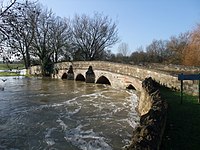
The origin of the name of the river is unknown but “Welland” appears to be Pre-English.[34] In Old English the form was Weolud and may have changed to the Middle English form due to folk-etymology or Scandinavian influence.[35][36] The Welland (Weolud) is first mentioned in the Anglo-Saxon Chronicle for 917.[37]
Richard de Rulos, who was Lord of Deeping Fen during the reign of William the Conqueror erected a strong embankment to prevent flooding of the meadows adjoining the river, which then became fertile fields and a pleasure garden.[38] During the reign of Henry III (1207–1272), complaints were made that of the two channels below Crowland, the one to Spalding was more favourable to the passage of barges, but the Abbot of Crowland had obstructed and narrowed its course by planting willow trees.[39] In the fourteenth century, Spalding was charged with failing to scour and repair the river, causing damage to the king's liege people, but argued that because it was tidal at this point, it was an arm of the sea, and so they were not responsible.[40]
The river was one of the earlier rivers to be granted an Act of Parliament for improvements, to allow navigation to Stamford. The Act was passed in the reign of Elizabeth I in 1571, and recited how Stamford had prospered as a result of the river, but also stated that mills built between Stamford and Deeping had resulted in it no longer being navigable, as they had diverted the water. Powers were granted to restore the river using either the old channel or the new one, although it is not clear exactly what was meant by this. There is no evidence that any work was carried out under the terms of the Act.[38]
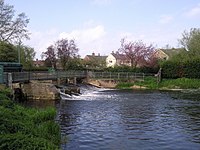
The powers were revived in 1620, when Stamford Corporation was given permission by the Commission of Sewers to build a new artificial cut 9½ miles long, which would run from the eastern edge of Stamford near Hudd's Mill, to Market Deeping, where it would rejoin the river. The decision was ratified in 1623 by a grant of James I, and the corporation expected to have the work completed by 1627 but they were unable to find a suitable contractor and failed to reach agreement on terms with David Cecil, until in 1664, Daniel Wigmore of Stamford took the job on and built the cut and 12 locks, which included the High Lock and the Low Lock on the river at Deeping St James, in return for the lease of the tolls for the next 80 years. The cut, known as the Stamford Canal, is one of the earliest post-Roman canals in Britain.[41]
The people of Market Deeping, Deeping Gate and Deeping St James, together with other villages along the river presented a petition to Elizabeth I, requesting that the fens should be drained, as the banks of the river and of the neighbouring Glen were in a poor state of repair. They suggested that Thomas Lovell should undertake the work, which he did, at a cost of £12,000, for which he received 15,000 acres of the land which was reclaimed as a result of the work. Unrest in the early 1600s resulted in most of the works being destroyed, but in 1632 a group of adventurers led by the Earl of Bedford were granted permission to drain Deeping Fen, South Fen and Crowland. The work included making the Welland deeper and wider from Deeping St James to its outfall beyond Spalding, and the construction of side drains. These included a drain running from Pode Hole to below Spalding, which is still known as Vernatt's Drain, after one of the adventurers called Sir Philibert Vernatti. Although declared completed in 1637, efficient drainage would have to wait until the construction of Pode Hole pumping station in 1827.[42]
At Crowland the river used to split into two channels, one broadly following the present course of the river, and the other joining the old South Ea to reach the River Nene near Wisbech. Dugdale, writing in 1662, described the Spalding channel as "a most slow course".[43] The river no longer flows through Crowland, but the unique triangular Trinity Bridge, which spanned the junction, remains in the centre of the town.[44][45]
Spalding had been a port from before any of the river improvements were made. The townspeople had refused to repair the river during the reign of Henry III, as they claimed it was part of the sea here. Its importance as a port increased with the river improvements and the Stamford Canal, and although it did not have a customs house, by 1695 it had various officials who acted as customs officers for goods arriving at the quays and warehouses. Exports included oats, coleseed, rape oil, hides and wool, with a much greater variety of imports, including stone, timber, coal, groceries, glass and beeswax. More exotic imports included French and Spanish wines, and some of the first imports of tea, coffee and chocolate.[46]
The Outfall
Plans to re-route the outfall along a new channel which would meet the River Witham at The Scalp, near Boston, were authorised in 1794, but the money could not be raised at the time, due to the financial crisis caused by the French Wars.[47] A shorter channel had been finished by 1810 and further improvements followed over many years, including a scheme for enabling the river to scour its own channel using thorn branches.[48] The effects of the embankments had resulted in the bed of the river below Fosdyke being around 7 feet lower by 1845.[49]
The Land Drainage Act 1930 created the Welland Catchment Board which made further improvements and created the Coronation Channel around Spalding, opened in September 1953.
To address the habitat and environmental issues causes by such engineering work, the Welland Rivers Trust, a limited company and charitable trust, was set up in 2010. They are seeking to direct regeneration of the river by co-ordinating various organisations, which are known collectively as the Welland Valley Partnership. They published a major document outlining their proposals in February 2013.[50]
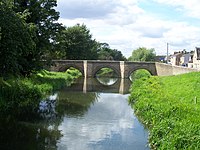
The river as far as Stamford was used by the Romans for navigation, as it formed part of a system including the Car Dyke,[27] which ran along the western edge of the Fens and crossed the river near the modern Folly River. Navigation to Stamford was improved by the canal. Boats used on the canal were small lighters, around 7 feet broad, capable of carrying from seven to fourteen tons, and normally worked in trains of four vessels. With the arrival of the railways, river trade declined. The Midland Railway reached Peterborough in 1846, and opened their line to Melton Mowbray, passing through Stamford, in 1848. Carriage of coal on the upper river stopped, and the locks deteriorated. By April 1863, all traffic had ceased, and Stamford Corporation tried to sell the line at auction, but failed because their ownership of it was disputed.[51]
Trade on the lower river was carried in barges and keels. During the early 1800s as trade was increasing, so the river was simultaneously silting up. Around 1800, vessels carrying 60 tons could reach the port facilities at Spalding; however, by the 1820s, ships could only be loaded with 40 tons each as the river silting had worsened. Trade records indicate that in 1829, vessels carried just under 20,000 tons to and from Spalding, and by 1835 this had increased to over 34,000 tons.[52] There was pressure from merchants to cater for larger vessels, and with later improvements, carried out under an act of parliament obtained in 1837, barges and sloops of up to 120 tons could use the port. Because the river was maintained for drainage, some commercial traffic continued despite the railways, and tolls of £478 were collected on 11,690 tons in 1888. Coal for Spalding gasworks arrived by boat until the early 1900s, and the last regular trade was the carriage of corn, hay and straw from Spalding to Fosdyke, where the cargo was transferred to larger ships. All commercial carrying had ceased by the end of the Second World War.[53]
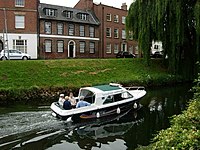
In July 2005 a water taxi service was launched in Spalding. Its route is from just off Spalding's High Street upstream along the river, turning onto the Coronation Channel, and going to Springfields Outlet Shopping & Festival Gardens, and back.[54]
Vessels of 110 feet by 30 feet and drawing up to 8 feet can still proceed along the estuary at high water, and can travel inland as far as Fulney lock. They cannot pass through the lock as it is only 62 foot 4 inches by 27 foot 9 inches and at normal summer water levels, can accommodate boats drawing 2 foot 8 inches. The river is officially navigable to the point at which the Folly River joins it, but the length of boats allowed on this section is restricted to 35 feet long; considerably less than the lock dimensions would suggest.[27] Navigation on this stretch was severely restricted by Four Mile Bar footbridge, which provided just 5 foot 3 inches of headroom, but this was increased when a new single-span arched bridge was installed in early 2007 by the Lincolnshire Waterways Partnership.[55] Smaller boats such as canoes, which can be carried around obstructions, can continue up to Stamford,[27] but they must use the old course of the river through the Deepings, rather than the Maxey cut.[56]
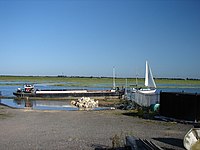
Below Spalding, there were no restrictions on headroom, which allowed small coasters to reach the town. The bridge at Fosdyke was a swing bridge, to comply with the provisions of the Fosdyke Bridge Act of 1870. The demise of such traffic allowed it to replaced by a fixed bridge with headroom of 16 foot 6 inches, but the powers of the original act had to be rescinded, and the Port of Fosdyke Act was obtained in 1987 to allow this to happen.[57][58] The redundant wharfs at Fosdyke have been developed to provide moorings for yachts and other pleasure craft.[27] The lock at Fulney has three sets of gates, two pointing towards the sea, and a third between them which points upriver. The lock can thus only be used when the level below it is higher than the level above it, and as the tide falls, the intermediate gate closes to prevent its use.[56]
The principle of there being no tolls for use of the river was established by the 1664 act of parliament. This was reversed by the 1794 act, which imposed high tolls, until they were reduced by the provisions of an act of Parliament obtained in 1824.[47] The river is now managed by the Environment Agency between Stamford and just below Fosdyke bridge, and a licence is required to use it. From there to the Wash, it was managed by the Port of Fosdyke Authority,[27] but since they went into administration, the Environment Agency have also managed the section from Fosdyke Bridge to below the Holbeach River.[59]
Wildlife
The river, in its upper reaches, supports a wild brown trout population. Chub and perch dominate the middle reaches around Stamford, with pike, perch and zander inhabiting the lower lengths around Spalding.
A collaboration between the Welland Rivers Trust, the Wild Trout Trust and the Environment Agency has resulted in the construction of a rock ramp, to allow migrating sea trout to pass up the river beyond the weir on the Maxey Cut, which was acting as a barrier. Some 300 tons of rock, with 50 tons of finer material forming a top layer, were used to create the ramp. The finer material ensures that water mainly flows over the ramp, rather than through it. The ramp also enables young eels or elvers to move up the river, and provides habitat for stone loach and bullheads.[60]
Large numbers of swans and geese use the river around Crowland, and out to sea. Smaller populations of each can be seen around the Stamford Meadows, and further upstream.
On the south bank of the river below Fosdyke bridge, the Lincolnshire Wildlife Trust have established Moulton Marsh nature reserve, on a strip of land where soil was excavated to raise the banks in 1981. Habitat is provided by some broad-leafed woodland, covering 15 acres, several salt-water lagoons and tidal scrapes, covering 35 acres, and 40 acres of saltmarsh. A variety of birds can be seen, including little grebe and water rail, which spend the winter on the lagoons, while the scrapes, which consist of shallow pools and muddy shorelines, are visited by common redshank and little egret.[61]
Between the river mouth and the River Witham, a large expanse of saltmarsh provides breeding grounds for common redshank, oystercatcher and reed bunting in the summer, and wigeon, mallard, common shelduck and common teal in the winter. Birds of prey such as hen harrier and Merlin (bird)|merlin feed on the flocks of linnet and twite, while the mudflats support dunlin, whimbrel, and bar-tailed godwit. The Lincolnshire Wildlife Trust have a reserve there,[62] which is next to RSPB Frampton Marsh, a reserve managed by the Royal Society for the Protection of Birds.[63]
Outside links
| ("Wikimedia Commons" has material about River Welland) |
- Welland Rivers Trust
- Welland Valley Partnership
- Environment Agency guide to the Welland
- Photographs of Glen and Welland
References
- ↑ Environment Agency (December 2009). "River-Welland-Catchment-Flood-Management-Plan-December-2009.pdf". pdf.js. http://southeastlincslocalplan.org/files/2012/02/River-Welland-Catchment-Flood-Management-Plan-December-2009.pdf. Retrieved 24 May 2013.
- ↑ 2.0 2.1 "Welland (UK) Operational HELP basin". UNESCO. http://portal.unesco.org/science/es/ev.php-URL_ID=3800&URL_DO=DO_PRINTPAGE&URL_SECTION=201.html. Retrieved 17 March 2011.
- ↑ National Heritage List 1287452: Bridge near Thorpe Lubenham Hall
- ↑ National Heritage List 1360740: Old Lubenham Hall
- ↑ National Heritage List 1012566: Old Hall moated site
- ↑ National Heritage List 1061659: Bridge over River Welland
- ↑ National Heritage List 1052134: Bridge in Ashley Civil Parish
- ↑ National Heritage List 1294980: Causeway leading to River Welland bridge
- ↑ National Heritage List 1286623: Welland Viaduct
- ↑ Labrum 1994, p. 213.
- ↑ National Heritage List 1073976: Turtle Bridge
- ↑ National Heritage List 1073960: Bridge in Barrowden
- ↑ National Heritage List 1040112: Duddington Mill
- ↑ National Heritage List 1040110: Duddington Bridge
- ↑ Dr David Harper. "The Welland Basin". University of Leicester. http://www2.le.ac.uk/departments/biology/people/harper/the-welland-basin. Retrieved 17 March 2011.
- ↑ National Heritage List 1040110: St Martin's Bridge, Stamford
- ↑ National Heritage List 1359564: St Martin's Bridge, Stamford
- ↑ National Heritage List 1007690: Ruins and site of St Leonard's Priory
- ↑ National Heritage List 1261587: Hudd's Mill
- ↑ National Heritage List 1062611: Tallington Mill
- ↑ National Heritage List 1062611: Molecey's Mill and Granary
- ↑ Labrum 1994, p. 74.
- ↑ National Heritage List 1126721: Bridge over ditch by Lolham Mill
- ↑ National Heritage List 1165282: Bridge over Mill Stream, Lolham Mill
- ↑ National Heritage List 1317148: Pair of bridges over River Welland
- ↑ National Heritage List 1309230: Deeping Gate Bridge
- ↑ 27.0 27.1 27.2 27.3 27.4 27.5 Cumberlidge 2009, p. 326
- ↑ Wheeler & Batty 1896, p. 291
- ↑ Labrum 1994, p. 83.
- ↑ Cumberlidge & 2009 pp.124-125.
- ↑ "Blooming industry". Historic Spalding. http://www2.spaldingtoday.co.uk/sites/history/bulbs.html. Retrieved 2 May 2011.
- ↑ National Monuments Record: No. 1341736 – Summary of Navigation on the River Welland
- ↑ "Welland and Deepings IDB". http://www.wellandidb.org.uk/.
- ↑ Mills, A.D (2003). Oxford dictionary of English placenames. Oxford University Press. p. Welland. ISBN 978-0-19-852758-9. "A Celtic or Pre-celtic rivername of unknown meaning"
- ↑ Cox 1994, p. 3
- ↑ Ekwall 1928, p. 446
- ↑ Anglo-Saxon Chronicle Parker Chronicle (917) 7 eal se here þe to Hamtune hierde norþ oþ Weolud, 7 sohton hine him to hlaforde 7 to mundboran ("and all the army of Northampton went northward to the Welland and sought him to be lord and protector")
- ↑ 38.0 38.1 Boyes & Russell 1977, pp. 236–239
- ↑ Wheeler & Batty 1896, p. 292
- ↑ Wheeler & Batty 1896, p. 295
- ↑ Labrum 1994, p. 75.
- ↑ Boyes & Russell 1977, pp. 241–242
- ↑ Boyes & Russell 1977, p. 236
- ↑ National Monuments Record: No. 352293 – Holy Trinity Bridge
- ↑ Boyes & Russell 1977, p. 242
- ↑ Boyes & Russell 1977, pp. 242–243
- ↑ 47.0 47.1 Boyes & Russell 1977, p. 246
- ↑ Boyes & Russell 1977, pp. 248–250
- ↑ Wheeler & Batty 1896, p. 305
- ↑ "Welcome to The Welland Rivers Trust". Welland Rivers Trust. http://www.wellandriverstrust.org.uk/.
- ↑ Boyes & Russell 1977, p. 241
- ↑ Saunders 1836, p. 123.
- ↑ Boyes & Russell 1977, pp. 246–247
- ↑ Spalding water taxi
- ↑ Powell 2007, pp. 1, 3.
- ↑ 56.0 56.1 Users Guide 2008
- ↑ Edwards 1985, p. 388
- ↑ "House of Lords debate". Hansard. 5 December 1983. http://hansard.millbanksystems.com/lords/1983/dec/05/fosdyke-bridge-bill-hl. Retrieved 17 December 2010.
- ↑ "Welland and Glen Navigation Guide". Environment Agency. http://www.fenswaterways.com/Portals/0/docs/navigation_guides/Welland_Glen_Navigation_Guide.pdf. Retrieved 21 March 2011.
- ↑ "Ramping up efforts to help rare fish". Welland Rivers Trust. http://www.wellandriverstrust.org.uk/index.php?option=com_content&view=category&layout=blog&id=1&Itemid=50. Retrieved 21 March 2011.
- ↑ "Moulton Marsh". Lincolnshire Wildlife Trust. http://www.lincstrust.org.uk/reserves/nr/reserve.php?mapref=99. Retrieved 18 December 2010.
- ↑ "Frampton Marsh". Lincolnshire Wildlife Trust. http://www.lincstrust.org.uk/reserves/nr/reserve.php?mapref=19. Retrieved 25 April 2011.
- ↑ "About Frampton Marsh". RSPB. http://www.rspb.org.uk/reserves/guide/f/framptonmarsh/about.aspx. Retrieved 25 April 2011.
Books
- Boyes, John; Russell, Ronald (1977). The Canals of Eastern England. David and Charles. ISBN 978-0-7153-7415-3.
- Cox, Barrie (1994). The place-names of Rutland. English Place-Name Society. ISBN 978-0-904889-17-8.
- Cumberlidge, Jane (2009). Inland Waterways of Great Britain (8th Ed.). Imray Laurie Norie and Wilson. ISBN 978-1-84623-010-3.
- Edwards, L A (1985). Inland Waterways of Great Britain (6th Ed). Imray Laurie Norie and Wilson. ISBN 978-0-85288-081-4.
- Ekwall, Eilert (1928). English river-names. Clarendon Press.
- Labrum, E.A. (1994). Civil Engineering Heritage: Eastern and central England. Thomas Telford. ISBN 978-0-7277-1970-6. http://books.google.co.uk/books?id=Offfz1NSDt0C&pg=PA75#v=onepage&q&f=false. Retrieved 24 May 2013.
- Powell, Mary (March 2007). "Bridge over the Welland". Newsletter 12 (Lincolnshire Waterways Partnership). http://www.woodhallspa.com/downlaods/LWP_Newsletter_12.pdf.
- Saunders, Mary (1836). Lincolnshire in 1836. John Saunders.
- Skempton, Sir Alec et al. (2002). A Biographical Dictionary of Civil Engineers in Great Britain and Ireland: Vol 1: 1500 to 1830. Thomas Telford. ISBN 978-0-7277-2939-2.
- Users Guide (2008). The Rivers Welland and Glen Users Guide. Environment Agency. http://www.fenswaterways.com/Portals/0/docs/navigation_guides/Welland_Glen_Navigation_Guide.pdf.
- Wheeler, William Henry; Batty, Leonard Charles (1896). A History of the Fens of South Lincolnshire. British Library Historical Print Collections. ISBN 978-1-241-32839-9.
- Edwards, Samuel, ed (1810). Extracts taken from Harod's history of Stamford: relating to the navigation of the River Welland from Stamford to the Sea. Stamford.
